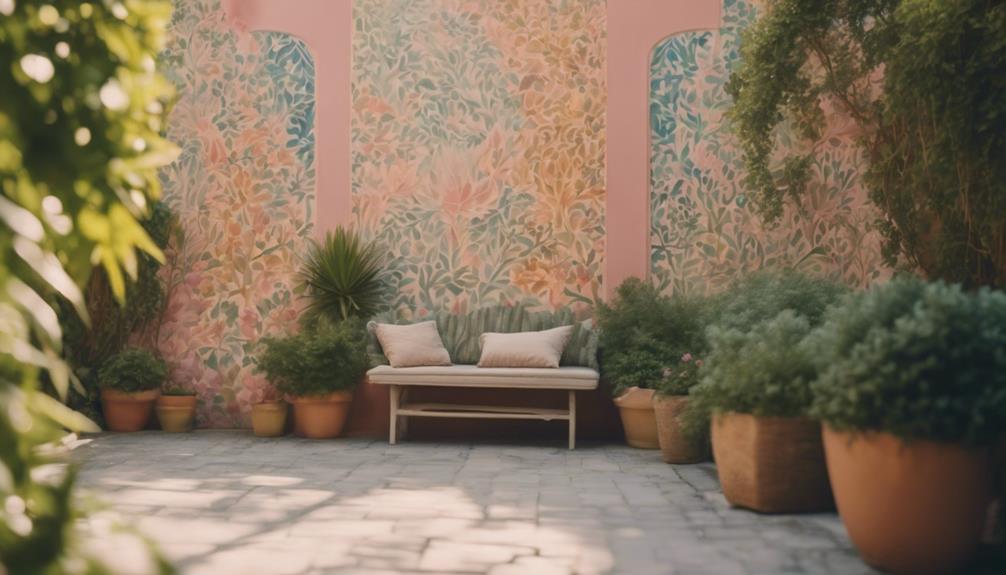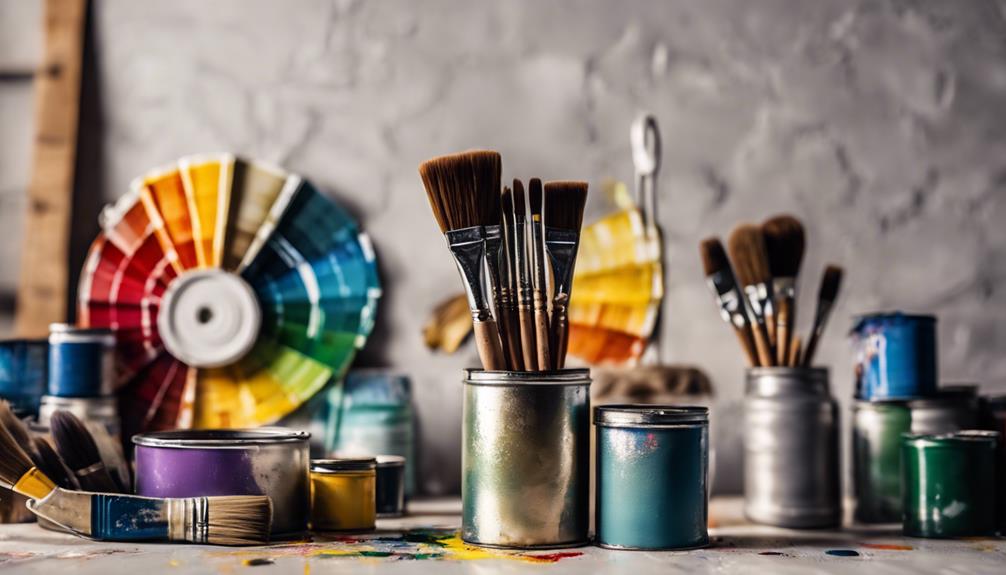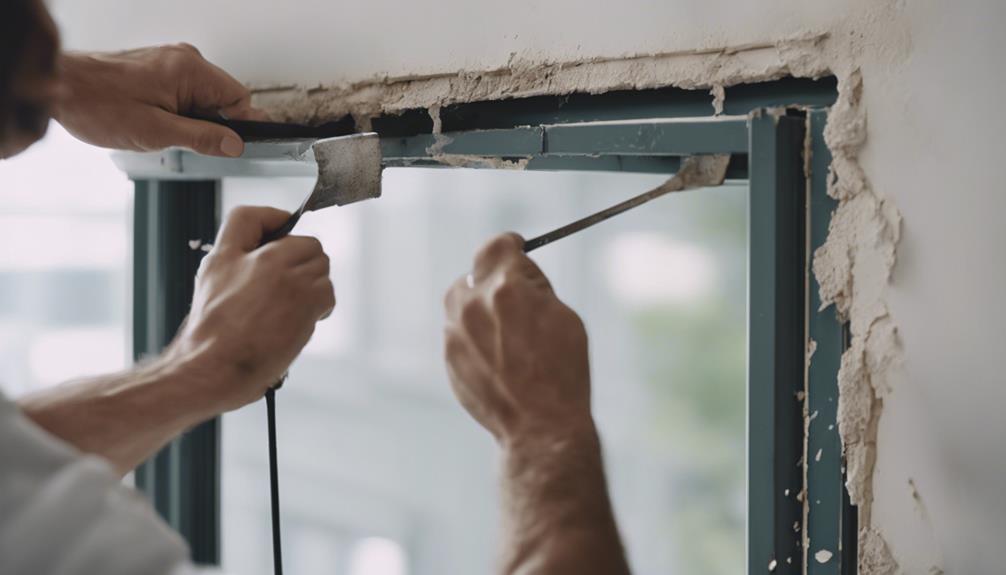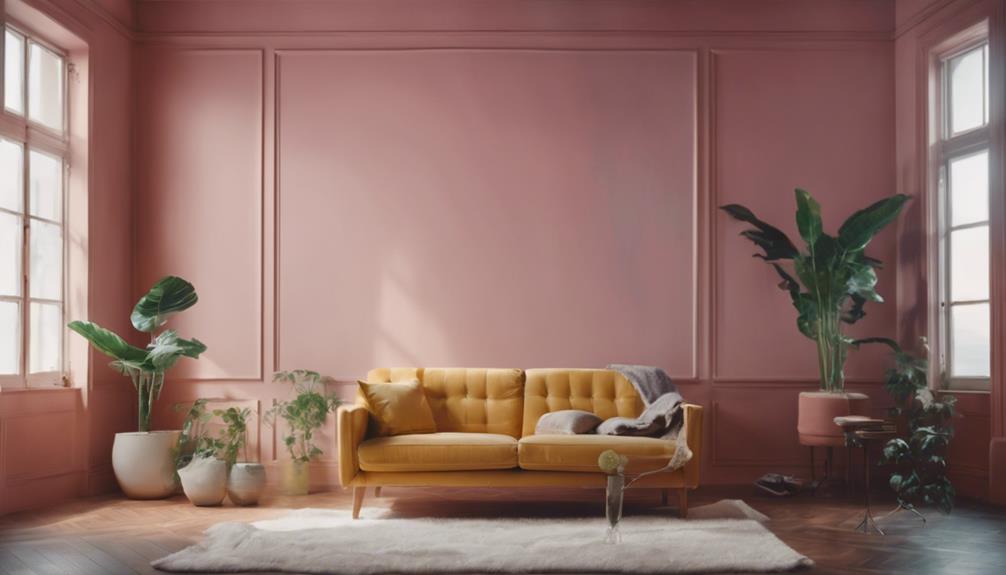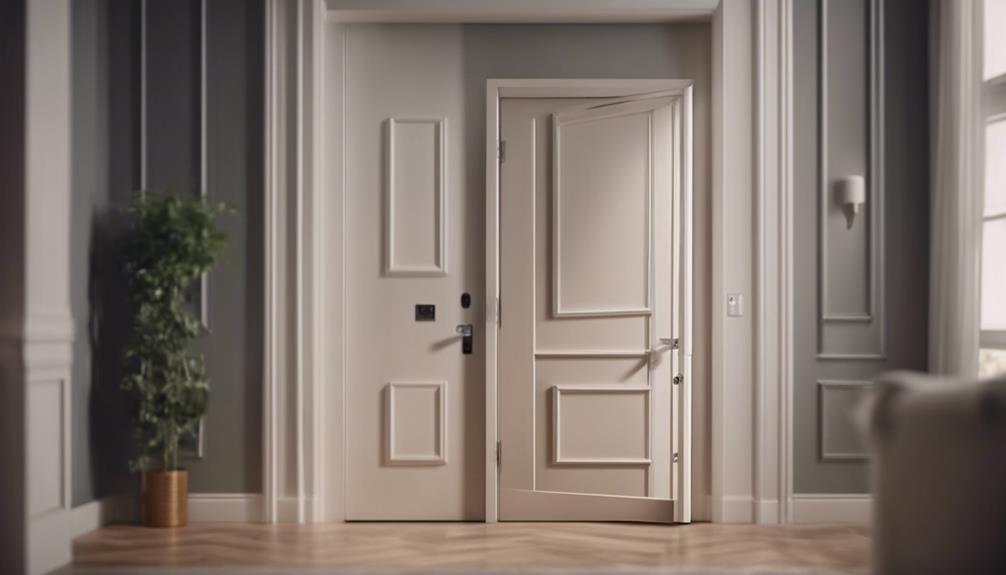You shouldn't use interior paint outside. Why? Because interior paint isn't built to handle the harsh outdoor world. It lacks the toughness and durability needed to battle sun, rain, and wind. When you slap interior paint on exterior surfaces, it's like sending a kitten into a lion's den. The result? Peeling, fading, and a mess that you'll need to fix sooner than you think. Want to know more about why interior paint is an indoor warrior? Stick around for some expert insights on how to paint smart, especially when Mother Nature is your opponent.
Key Takeaways
- Interior paint lacks durability for outdoor use due to insufficient weather resistance.
- Exterior paint is engineered to withstand elements better than interior paint.
- Using interior paint outside can lead to peeling, fading, and other maintenance issues.
- Proper surface preparation is crucial for outdoor painting to prevent premature paint failure.
- Experts recommend using exterior paint for longevity and protection against outdoor elements.
Interior Vs Exterior Paint Differences
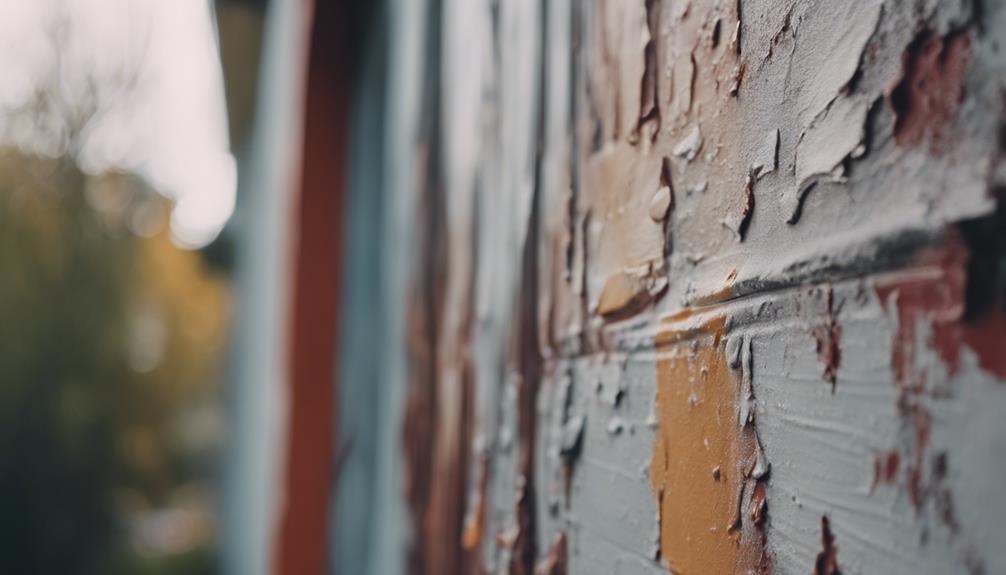
Exterior paint outperforms interior paint in durability and weather resistance, making it the preferred choice for outdoor applications. The key difference lies in the composition of the paints.
Interior paint is designed for indoor use, with lower VOC levels for safer indoor air quality. On the other hand, exterior paints contain more durable binders that can withstand harsh outdoor conditions like rain, sun exposure, and temperature fluctuations. These binders provide better adhesion and protection against weather elements, ensuring your outdoor paint job lasts longer without peeling, cracking, or fading.
Outdoor paint also includes additives for weather resistance and UV protection, features that are essential for maintaining the appearance and integrity of surfaces exposed to the elements. Professional painters highly recommend using exterior paint for outdoor projects to guarantee longevity and durability, as interior paint lacks the necessary components to withstand outdoor wear and tear.
Risks of Using Interior Paint Outside
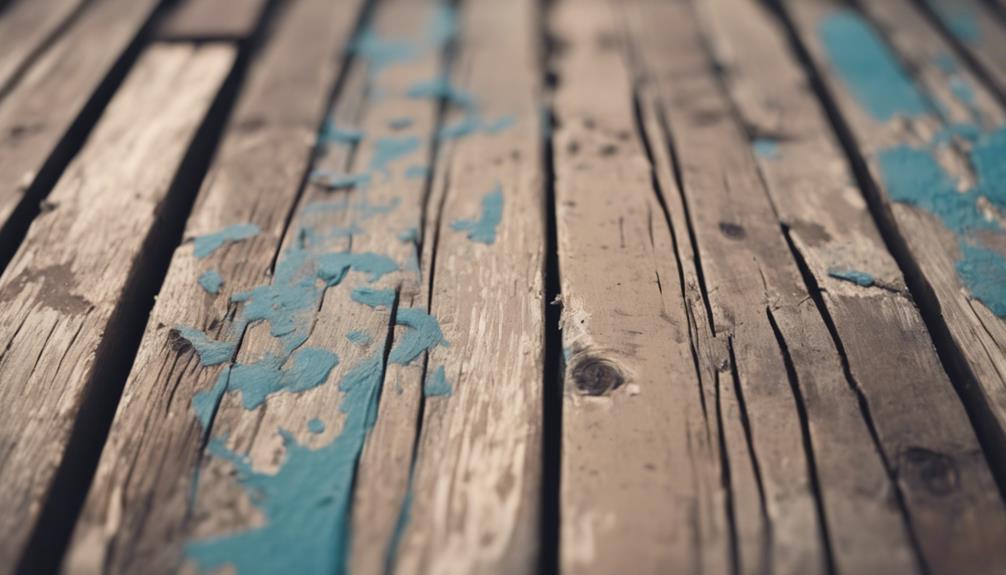
Using interior paint outside poses significant risks, including durability issues, weather-related damage, and the importance of proper surface preparation.
Exterior paint is engineered to withstand outdoor conditions better than interior paint, which can deteriorate quickly when exposed to the elements.
Ensuring the surface is well-prepped before painting can help mitigate some of the challenges associated with using interior paint outside.
Exterior Paint Durability
When painting outdoors, it's crucial to prioritize durability by selecting the right type of paint that can withstand harsh weather conditions. Exterior paint is specifically formulated to endure outdoor surfaces exposed to UV rays, moisture, and temperature fluctuations.
Unlike interior paint, exterior paint offers superior adhesion and resilience against the elements, guaranteeing a long-lasting finish. Using interior paint outside can result in peeling, cracking, and color fading due to its lack of necessary additives and binders found in exterior paint.
To maintain the integrity of your outdoor project, opt for exterior paint designed to withstand the challenges of outdoor environments. Prioritizing durability ensures your paint job remains vibrant and protected against the rigors of nature.
Weather Impact on Paint
Interior paint applied outdoors is vulnerable to peeling, cracking, and color fading due to exposure to weather elements. The harsh outdoor elements, such as sunlight, rain, and humidity, can cause interior paint to deteriorate quickly.
This fading due to exposure to weather conditions can make your painted surfaces look dull and unattractive. Additionally, interior paint may not have the necessary resistance to mold growth when used outside, posing health risks.
To guarantee your outdoor projects stand the test of time, it's recommended to opt for exterior paint, specially formulated to withstand the outdoor elements. By choosing the right paint for your outdoor surfaces, you can enjoy long-lasting color vibrancy and protection against weather-related damage.
Surface Preparation Importance
Proper surface preparation is vital before applying paint outside to guarantee strong adhesion and durability. Neglecting surface preparation can result in peeling, cracking, and reduced paint longevity.
When contaminants like dirt, grease, or old paint remain on the surface, they hinder paint adhesion, leading to premature paint failure. By thoroughly preparing the surface, you make sure that the paint adheres well and forms a lasting bond. Removing impurities and creating a clean, smooth surface is key to preventing issues that could compromise the paint finish over time.
Take the time to prepare the surface correctly before painting outside to avoid potential problems and enjoy a more durable and long-lasting result.
Exterior Paint for Outdoor Surfaces

For outdoor projects, selecting exterior paint is crucial to guarantee longevity and protection against the elements. Exterior paint is specifically formulated to withstand outdoor conditions, offering superior weather resistance, UV protection, and overall durability compared to interior paint. Professional painters highly recommend using exterior paint for outdoor surfaces to ensure lasting quality and peak performance. Here's a helpful comparison table to illustrate the differences between exterior and interior paint:
| Feature | Exterior Paint | Interior Paint |
|---|---|---|
| Weather Resistance | Specially designed for outdoor use, can withstand sunlight, moisture, and temperature changes | Not designed for outdoor elements, prone to peeling and fading outdoors |
| UV Protection | Contains UV-resistant additives to prevent color fading and damage | Lacks sufficient UV protection, leading to color changes over time |
| Durability | Thicker consistency for better coverage and resilience against harsh outdoor conditions | Thinner consistency, not as durable for exterior use |
Choosing the right paint for your outdoor painting projects can make a significant difference in the longevity and appearance of the surfaces.
Using Interior Paint Outdoors: Considerations
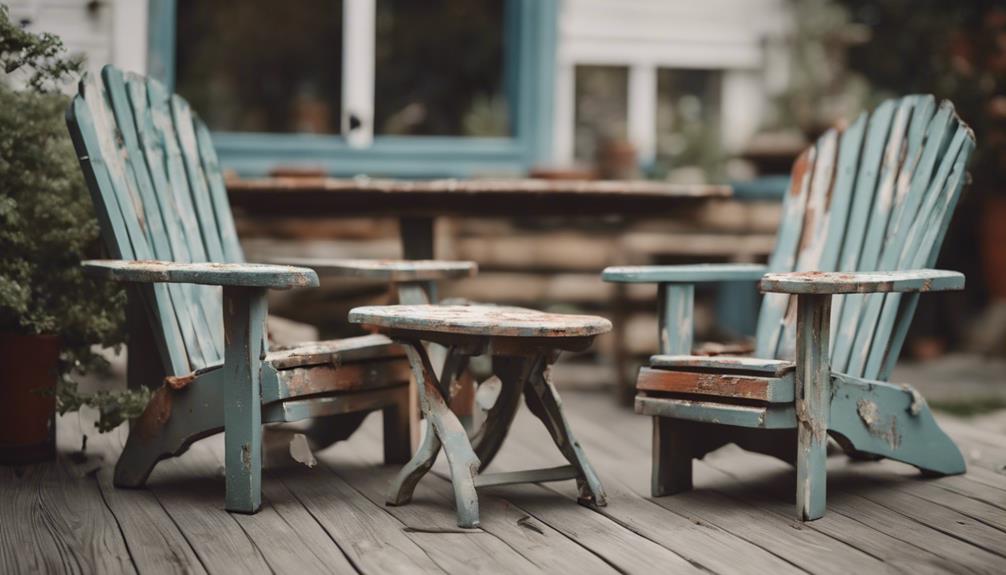
Consider the potential drawbacks of using interior paint outdoors before proceeding with your project. Interior paint isn't formulated to withstand outdoor elements like sunlight, moisture, and temperature changes. This can result in issues such as peeling, cracking, blistering, and color fading when used on exterior surfaces. Unlike exterior paint, interior paint lacks heavy-duty chemicals like mildewcide for weather resistance, making it less suitable for outdoor use. Additionally, interior paint may take longer to dry when used outside due to its different formulation and consistency.
Professional painters highly recommend using exterior paint for outdoor projects to guarantee longevity and durability. Exterior paint is specifically designed to withstand various weather conditions and provides better moisture control, preventing issues like mold and mildew growth. By opting for exterior paint, you can be confident that your outdoor surfaces are well-protected and maintain their appearance over time. Make the wise choice and invest in the right paint for your outdoor endeavors.
Expert Insights on Interior Paint Usage
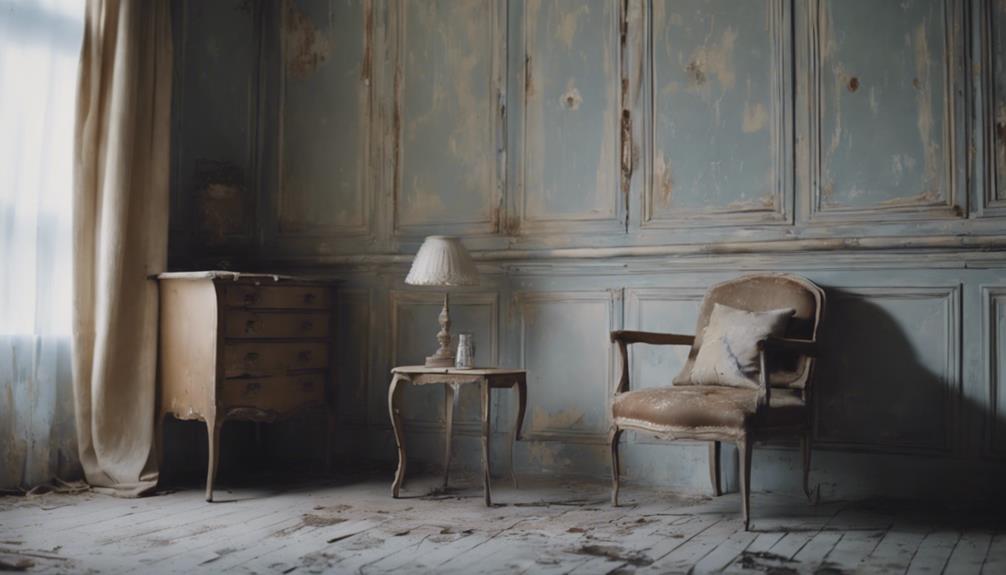
When it comes to painting projects, your interior paint might seem like a vital choice for outdoor surfaces. However, it's important to remember that interior paint lacks the tough ingredients needed to battle the elements outside.
If you want your paint job to last and look great, opt for exterior paint specifically designed to withstand the challenges of outdoor conditions.
Paint Durability Outdoors
Expert insights highlight the importance of recognizing that interior paint lacks the necessary durability to withstand outdoor conditions, leading to potential issues like peeling and color fading when used outside. Here are some key points to keep in mind:
- Exterior Paint Endurance: Exterior paint is formulated to withstand UV rays, moisture, and temperature changes, essential for outdoor projects.
- Professional Painter Advice: Professional painters recommend using exterior paint for outdoor applications to guarantee longevity and durability.
- Weather Resistance: Exterior paint offers superior weather resistance compared to interior paint, safeguarding surfaces from the elements.
- Chemical Protection: Exterior paint contains heavy-duty chemicals like mildewcide, essential for combating outdoor conditions and prolonging the life of the paint job.
Weather Resistance Considerations
Interior paint lacks the necessary additives for weather resistance, making it unsuitable for outdoor use. When exposed to outdoor elements like sun, rain, and wind, interior paint deteriorates quickly. Professional painters advise using exterior paint for better weather resistance. Exterior paint is specifically formulated to withstand harsh outdoor conditions, ensuring longevity and protection for your surfaces. Additionally, interior paint may struggle to adhere properly to exterior surfaces, leading to peeling and chipping. To maintain the integrity of your paint job and prevent premature deterioration, always opt for exterior paint when painting outdoor surfaces. By selecting the right paint for the job, you can guarantee a vibrant and long-lasting finish that stands up to the elements.
| Interior Paint | Exterior Paint |
|---|---|
| Lacks weather resistance | Formulated for outdoor use |
| Prone to deterioration | Resistant to outdoor elements |
| May not adhere well to exterior surfaces | Designed for longevity and protection |
| Unsuitable for outdoor use | Ideal for withstanding harsh conditions |
Consequences of Using Interior Paint Outside
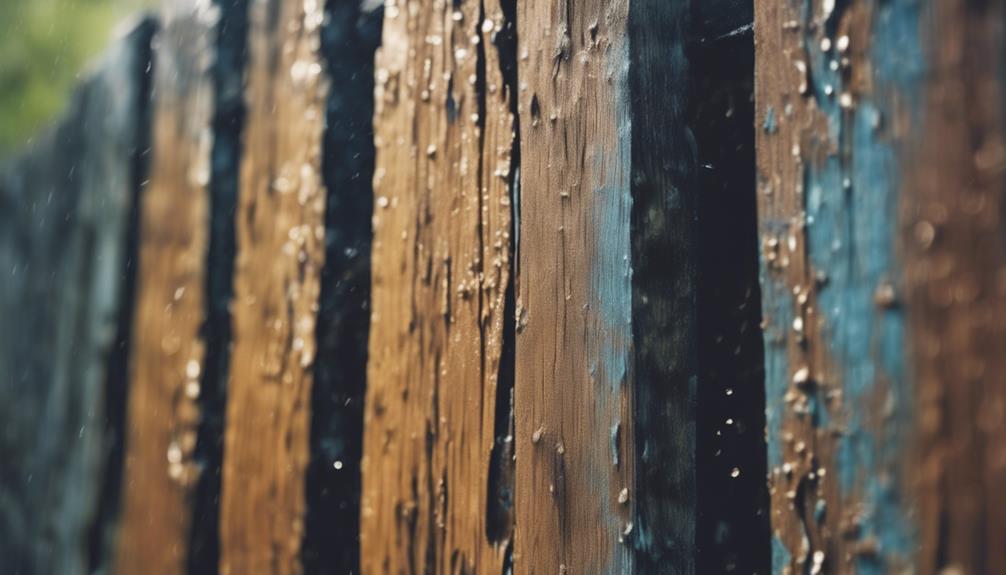
Using interior paint outside can result in costly maintenance issues such as peeling, cracking, and color fading due to its lack of durability against outdoor elements. To understand the consequences better, consider the following points:
- Durability Concerns: Interior paint isn't formulated to withstand the harsh outdoor elements like sunlight, moisture, and temperature fluctuations, leading to quicker wear and tear.
- Professional Recommendations: Experts suggest using exterior paint for outdoor projects to guarantee longevity and protection against weather conditions, preventing the need for frequent touch-ups.
- Chemical Variations: Unlike exterior paint, interior paint lacks heavy-duty chemicals like mildewcide, making it more susceptible to mold and mildew growth when used outside.
- Repainting Needs: Using interior paint outside may necessitate repainting within a year or two, resulting in additional maintenance costs and efforts to keep the surfaces looking fresh.
Best Practices for Outdoor Painting
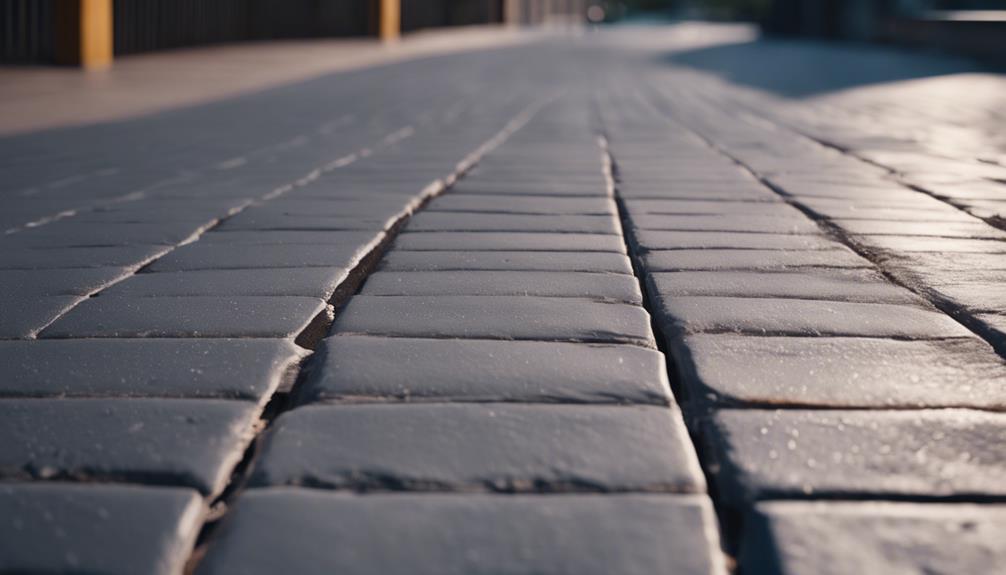
When painting outdoors, remember that durability is essential.
Proper surface preparation is vital for a successful project.
Consider the weather conditions to make sure your paint job withstands the elements.
Paint Durability Outdoors
For best durability and longevity when painting outdoors, it's essential to use exterior paint specifically formulated to withstand varying weather conditions.
- Exterior Surfaces: Exterior paint is designed to adhere better to outdoor surfaces like wood, metal, and concrete.
- Withstand the Elements: Exterior paint is formulated to resist sunlight, moisture, and temperature changes.
- Interior and Exterior Paints: Understanding the difference between interior and exterior paints is vital for a successful outdoor paint job.
- Durability Needed: The durability needed for outdoor surfaces can only be achieved with the use of exterior paint.
Surface Preparation Tips
To guarantee a successful outdoor paint job, begin by thoroughly cleaning the surface to remove dirt, debris, and loose paint before applying interior paint outside. Using a high-quality primer enhances adhesion and durability of interior paint on outdoor surfaces.
Make sure the surface is dry and free from moisture to prevent peeling and blistering of interior paint used outside. Lightly sanding the surface creates a smooth and even base for interior paint application in outdoor areas.
For better coverage and longevity, apply multiple thin coats of interior paint. Following these surface preparation tips will help your interior paint withstand the elements when used outside, ensuring a professional and long-lasting finish.
Weather Conditions Consideration
Given the influence of weather conditions on your outdoor painting project, it's crucial to choose the right type of paint that can withstand elements like rain, snow, and UV exposure.
When considering outdoor projects, remember these key points:
- Exterior paint is formulated for weather conditions: It provides durability and moisture resistance required for outdoor surfaces.
- Interior paint lacks moisture resistance: Using it outdoors can lead to peeling and fading due to exposure to harsh elements.
- Durability of exterior paint: It offers higher durability and flexibility to combat outdoor challenges.
- Professional painters recommend exterior paint: Experts suggest using exterior paint for outdoor projects to guarantee longevity and protection against weather-related damage.
Interior Paint Limitations Outdoors
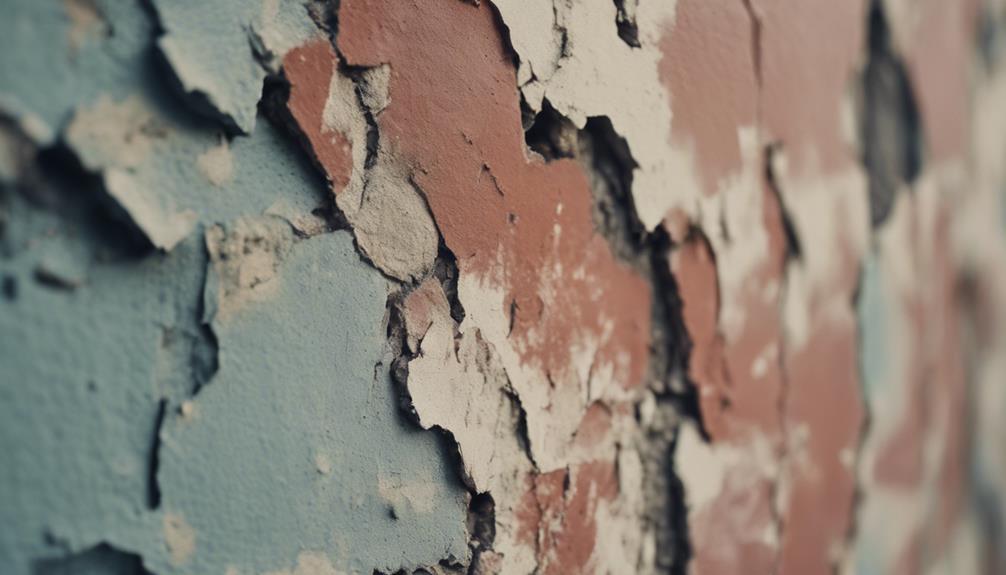
Using interior paint outside exposes it to elements it wasn't formulated for, leading to rapid deterioration and the need for frequent repainting. Interior paint lacks the additives necessary to withstand outdoor elements such as sun exposure, moisture, and temperature changes. This can cause issues like peeling, cracking, blistering, and fading when used outdoors. Since interior paint isn't designed for weather resistance, it may not adhere well to exterior surfaces, further contributing to its quick deterioration.
Professional painters recommend opting for exterior paint when working on outdoor projects to guarantee longevity and durability. Due to its limitations in outdoor environments, interior paint used outside may require repainting within a year or two. To avoid the hassle of frequent repainting and to ensure a long-lasting finish, it's best to choose paints specifically formulated for exterior use. By using the right paint for the job, you can enjoy a beautifully painted outdoor space that withstands the test of time.
Compatibility of Interior Paint for Exterior Use
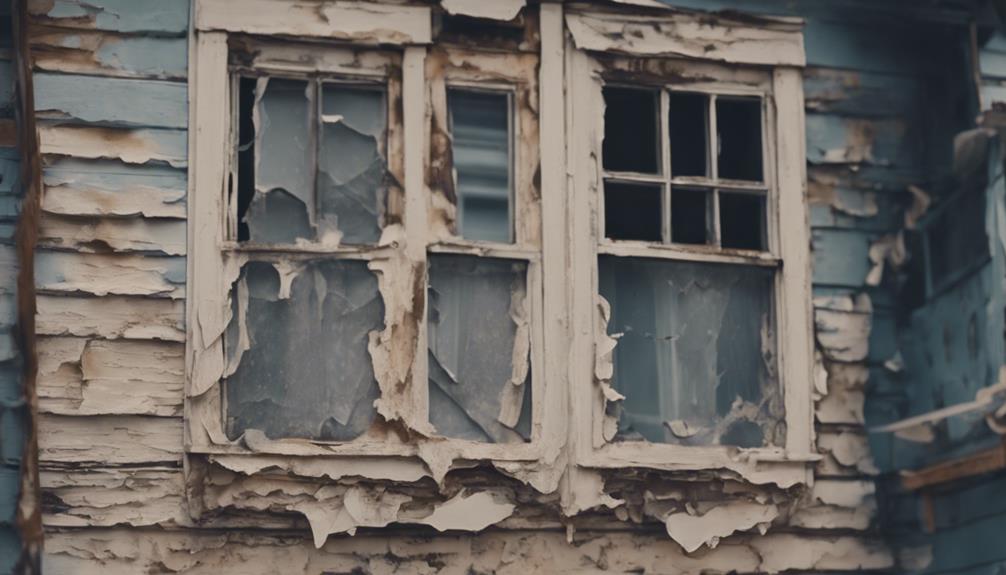
Lacking essential weather-resistant additives, interior paint proves incompatible for exterior use due to its vulnerability to outdoor elements such as moisture, UV rays, and temperature fluctuations. When considering using interior paint outside, it's important to understand why it may not be the best choice:
- Durability: Interior paint lacks the durability needed to withstand the harsh conditions of the outdoors, leading to issues like peeling, cracking, and fading.
- Adhesion: Interior paint may struggle to adhere properly to exterior surfaces, resulting in poor adhesion and a shorter lifespan when used outside.
- Mold Growth: Without heavy-duty chemicals like mildewcide found in exterior paint, interior paint is less resistant to mold growth when exposed to the elements.
- Weather Resistance: The weather-resistant properties of exterior paint are essential for long-term outdoor projects, ensuring longevity and protection against elements.
For a successful exterior project, it's recommended to opt for exterior paint specifically designed to combat outdoor challenges and provide a durable finish that can withstand varying weather conditions.
Expert Recommendations for Exterior Projects
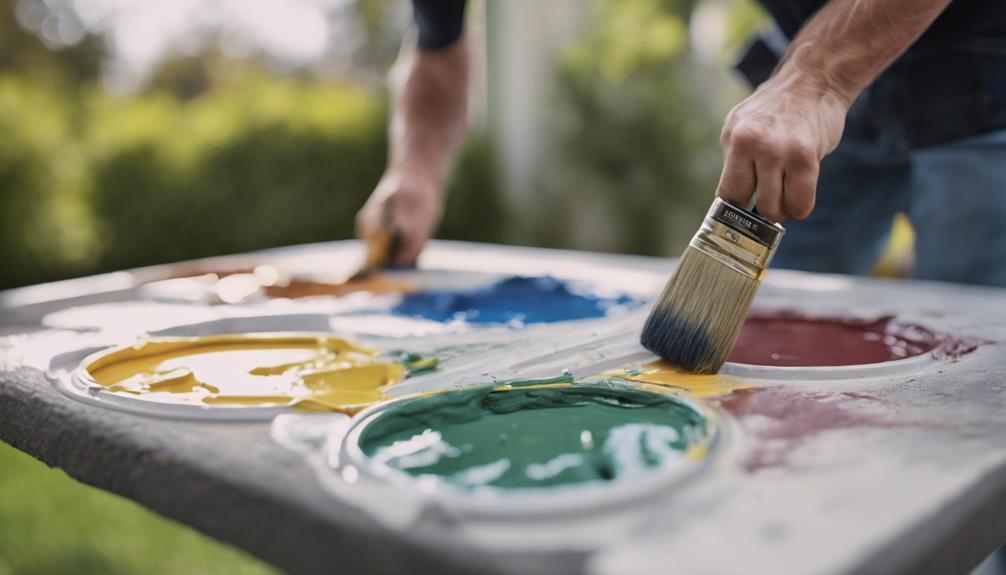
For successful exterior projects, professional painters strongly recommend opting for exterior paint specifically formulated to withstand outdoor elements and provide long-lasting durability. When it comes to painting outdoor surfaces, using interior paint is a big no-no. Interior paint lacks the necessary additives to combat weather conditions, leading to issues like peeling, cracking, and color fading over time. To guarantee your outdoor paint job stands the test of time, opt for exterior paint designed to resist the elements and maintain its quality for years to come.
Here's a handy comparison table to highlight the key differences between interior and exterior paint:
| Aspect | Interior Paint | Exterior Paint |
|---|---|---|
| Formulation | Not suitable for outdoor use | Specifically formulated for outdoor use |
| Durability | Prone to peeling, cracking, and fading | Resistant to weather conditions |
| Longevity | Shorter lifespan outdoors | Provides long-lasting results |
| Weather Resistance | Lacks protection against elements | Designed to withstand outdoor conditions |
| Professional Recommendation | Not advised for exterior projects | Recommended by experts for outdoor painting |
Frequently Asked Questions
What Will Happen if You Use Interior Paint Outside?
Using interior paint outside can lead to premature deterioration. Exposure to outdoor elements like UV rays and moisture can cause cracking, fading, blistering, and peeling. Interior paint lacks the durability of exterior paint, which contains protective chemicals like mildewcide.
While sealing interior paint can offer some protection, it's best to use exterior paint for long-lasting results. Remember, outdoor surfaces require paint designed to withstand nature's elements for best performance.
How Long Will Indoor Paint Last Outside?
If you place indoor paint outside, its lifespan is drastically shortened. The elements, like sunlight and moisture, will quickly wear it down. Without proper protection, you can expect fading, peeling, blistering, and cracking in a year or two.
To make it last longer, consider sealing it with a weather-resistant product. For durability, stick with outdoor paints designed to withstand the harsh outdoor conditions.
Is There Really a Difference Between Interior and Exterior Paint?
Yes, there's a significant difference between interior and exterior paint.
Exterior paint is specially formulated with more robust binders and pigments to withstand outdoor elements, while interior paint contains lower VOCs for indoor safety.
Using interior paint outside can result in peeling, cracking, and color fading due to its composition.
It's important to choose the right paint type for each project to guarantee durability and protection against weather conditions.
Can I Use Interior Paint on an Exterior Door?
You definitely can't use interior paint on an exterior door! That door needs tough love—like with exterior-specific paint.
The outdoor elements will wreck interior paint faster than you can say 'repaint.' Moisture, UV rays, temperature changes? Interior paint just can't handle it.
Save yourself the hassle of constant touch-ups and invest in the right paint for the job. Your door will thank you with a long, colorful life.
Conclusion
So, can you use interior paint outside?
In short, the answer is no. While it may seem like a quick fix, using interior paint on outdoor surfaces can lead to peeling, fading, and other issues.
It's like trying to wear a raincoat in a snowstorm – it just won't hold up.
Stick to exterior paint for your outdoor projects to guarantee a long-lasting finish that can weather the elements. Trust me, your walls will thank you!
